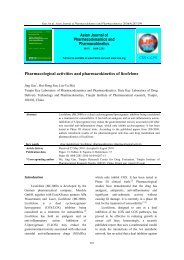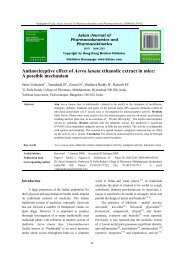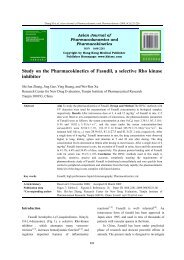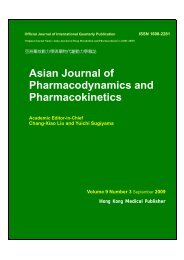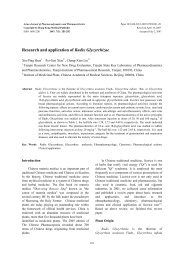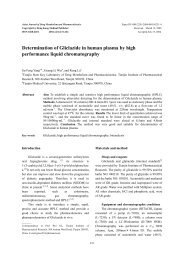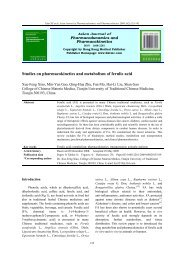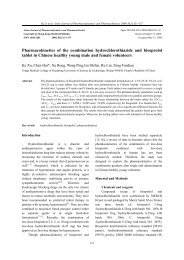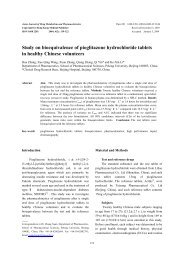Asian Journal of Pharmacodynamics and Pharmacokinetics
Asian Journal of Pharmacodynamics and Pharmacokinetics
Asian Journal of Pharmacodynamics and Pharmacokinetics
You also want an ePaper? Increase the reach of your titles
YUMPU automatically turns print PDFs into web optimized ePapers that Google loves.
Cheng TF et al. <strong>Asian</strong> <strong>Journal</strong> <strong>of</strong> <strong>Pharmacodynamics</strong> <strong>and</strong> <strong>Pharmacokinetics</strong> 2009; 9(1):27-49<br />
the tumor, cross vessel walls into the interstitium<br />
<strong>and</strong> penetrate multiple layers <strong>of</strong> solid tumor cells.<br />
Recent studies have demonstrated that poor<br />
penetration <strong>and</strong> limited distribution <strong>of</strong> doxorubicin<br />
in solid tumors are the main causes <strong>of</strong> its<br />
inadequacy as a chemotherapeutic agent.<br />
Encapsulation <strong>of</strong> doxorubicin into PEG-PE micelles<br />
increased its accumulation <strong>and</strong> penetration in<br />
tumors in terms <strong>of</strong> both the percentage <strong>of</strong> cells that<br />
were reached by the drug <strong>and</strong> the intracellular levels<br />
that were attained. This increased accumulation <strong>and</strong><br />
penetration can be attributed to the efficient<br />
internalization <strong>of</strong> the drug-containing micelles by<br />
the endocytotic cell uptake mechanism <strong>and</strong><br />
enhanced permeability <strong>and</strong> retention <strong>of</strong> tumors with<br />
leaky vasculature. High intracellular retention is<br />
especially important because doxorubicin must be<br />
internalized to be effective in tumor therapy. The<br />
doxorubicin- containing PEG-PE micelles had<br />
greatly increased antitumor activity in both<br />
subcutaneous <strong>and</strong> lung metastatic LLC tumor<br />
models compared with free doxorubicin. However,<br />
mice treated micelle- encapsulated doxorubicin<br />
showed fewer signs <strong>of</strong> toxicity than those treated<br />
with free doxorubicin. This drug packaging<br />
technology may provide a new strategy for design<br />
<strong>of</strong> cancer therapies. [29,30] At our laboratory, studied<br />
nanoparticle <strong>of</strong> doxorubicin eliminate the<br />
accumulation in tissues <strong>of</strong> tumor-bearing mice.<br />
Compared with general doxorubicin preparation,<br />
which is a marketed product, nanoparticle micelle<br />
<strong>of</strong> doxorubicin has the similar pharmacokinetics in<br />
the tissue, <strong>and</strong> the similar concentrations in the<br />
tumor tissue. Howerever, the accumulation <strong>of</strong><br />
doxorubicin in the heart, spleen, kidney, lung,<br />
tumor, muscle <strong>and</strong> skin decreased significantly after<br />
three intravenous injections, showing that the<br />
nano-micelle can accumulatew the elimilation <strong>of</strong><br />
doxorubicin in most tissues. It is deduced that the<br />
study was effects <strong>of</strong> doxorubicin after clinical use<br />
may be reduced significantly. [31]<br />
Pegylated liposomal doxorubicin is effective<br />
<strong>and</strong> well tolerated in relapsed ovarian cancer. When<br />
compared with topotecan in a phase III r<strong>and</strong>omized<br />
trial, pegylated liposomal doxorubicin showed<br />
several advantages: improved quality <strong>of</strong> life, fewer<br />
severe adverse events, fewer dose modifications,<br />
less hematologic support, <strong>and</strong> lower total cost per<br />
patient. In platinum-sensitive patients, pegylated<br />
liposomal doxorubicin also produced a survival<br />
advantage. Results from prospective <strong>and</strong><br />
retrospective studies further demonstrate the<br />
improved cardiac safety <strong>of</strong> pegylated liposomal<br />
doxorubicin compared to conventional<br />
anthracyclines. Based on survival <strong>and</strong> toxicity<br />
advantages <strong>and</strong> a once-monthly administration<br />
schedule, pegylated liposomal doxorubicin is the<br />
first-choice nonplatinum agent for relapsed ovarian<br />
cancer. Pegylated liposomal doxorubicin may also<br />
have clinical application in combination regimens<br />
for platinum-sensitive ovarian cancer, as<br />
consolidation/maintenance therapy for ovarian<br />
cancer, as a component <strong>of</strong> first-line therapy for<br />
ovarian cancer, <strong>and</strong> in the treatment <strong>of</strong> other<br />
gynecologic malignancies. Future clinical trials will<br />
further define <strong>and</strong> maximize the role <strong>of</strong> pegylated<br />
liposomal doxorubicin in the treatment <strong>of</strong> ovarian<br />
cancer <strong>and</strong> other gynecologic malignancies. [32]<br />
Doxorubicin nanoparticles<br />
A novel hyaluronic acid-poly(ethylene<br />
glycol)-poly(lactide-co-glycolide) (HA-PEG-PLGA)<br />
copolymer was synthesized <strong>and</strong> characterized by<br />
infrared <strong>and</strong> nuclear magnetic resonance<br />
spectroscopy. The nanoparticles <strong>of</strong> doxorubicin<br />
(DOX)-loaded HA-PEG-PLGA were prepared <strong>and</strong><br />
compared with monomethoxy (polyethylene glycol)<br />
(MPEG)-PLGA nanoparticles. Nanoparticles were<br />
prepared using drug-to-polymer ratios <strong>of</strong> 1:1 to 1:3.<br />
Drug-to-polymer ratio <strong>of</strong> 1:1 is considered the<br />
optimum formulation on the basis <strong>of</strong> low particle<br />
size <strong>and</strong> high entrapment efficiency. The optimized<br />
nanoparticles were characterized for morphology,<br />
particle size measurements, differential scanning<br />
calorimetry, x-ray diffractometer measu- rement,<br />
drug content, hemolytic toxicity, subacute toxicity,<br />
<strong>and</strong> in vitro DOX release. The in vitro DOX release<br />
study was performed at pH 7.4 using a dialysis<br />
membrane. HA-PEG-PLGA nanoparticles were<br />
able to sustain the release for up to 15 days. The<br />
tissue distribution studies were performed with<br />
DOX-loaded HA-PEG-PLGA <strong>and</strong> MPEG-PLGA<br />
nanoparticles after intravenous (IV) injection in<br />
Ehrlich ascites tumor–bearing mice. The tissue<br />
distribution studies showed a higher concentration<br />
<strong>of</strong> DOX in the tumor as compared with<br />
39



